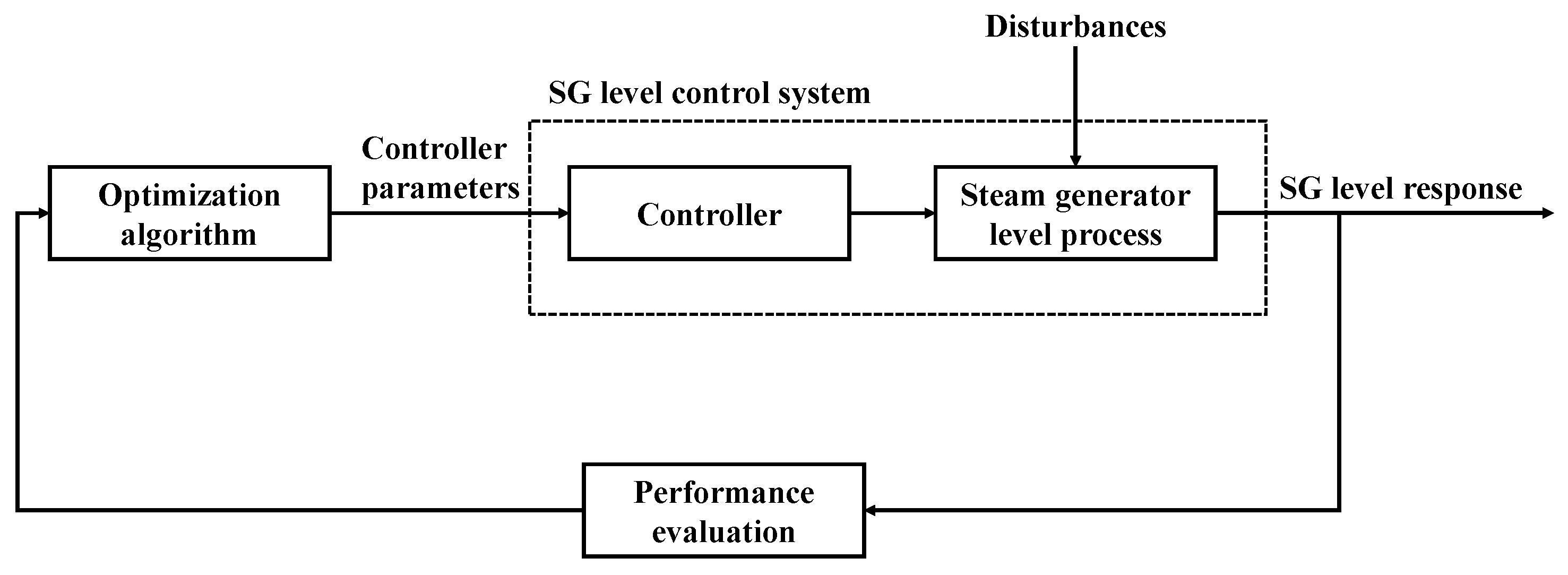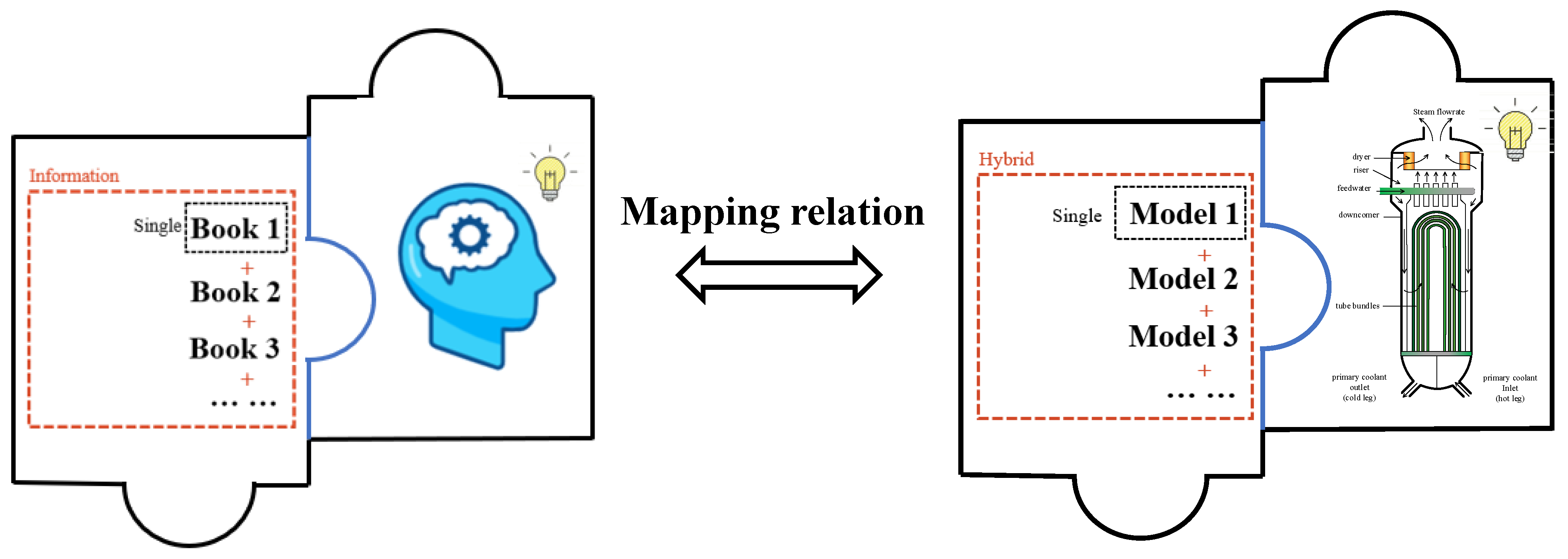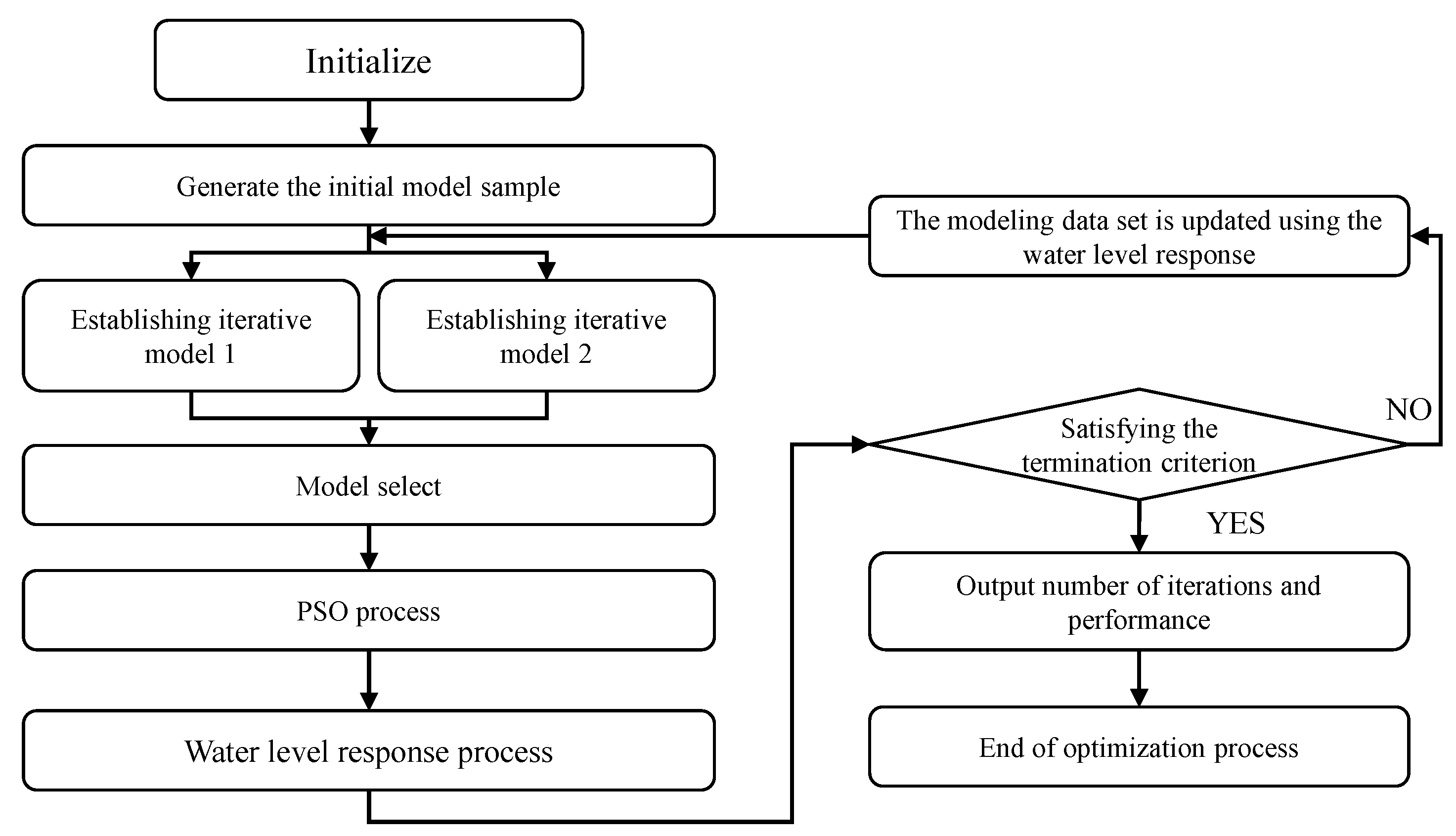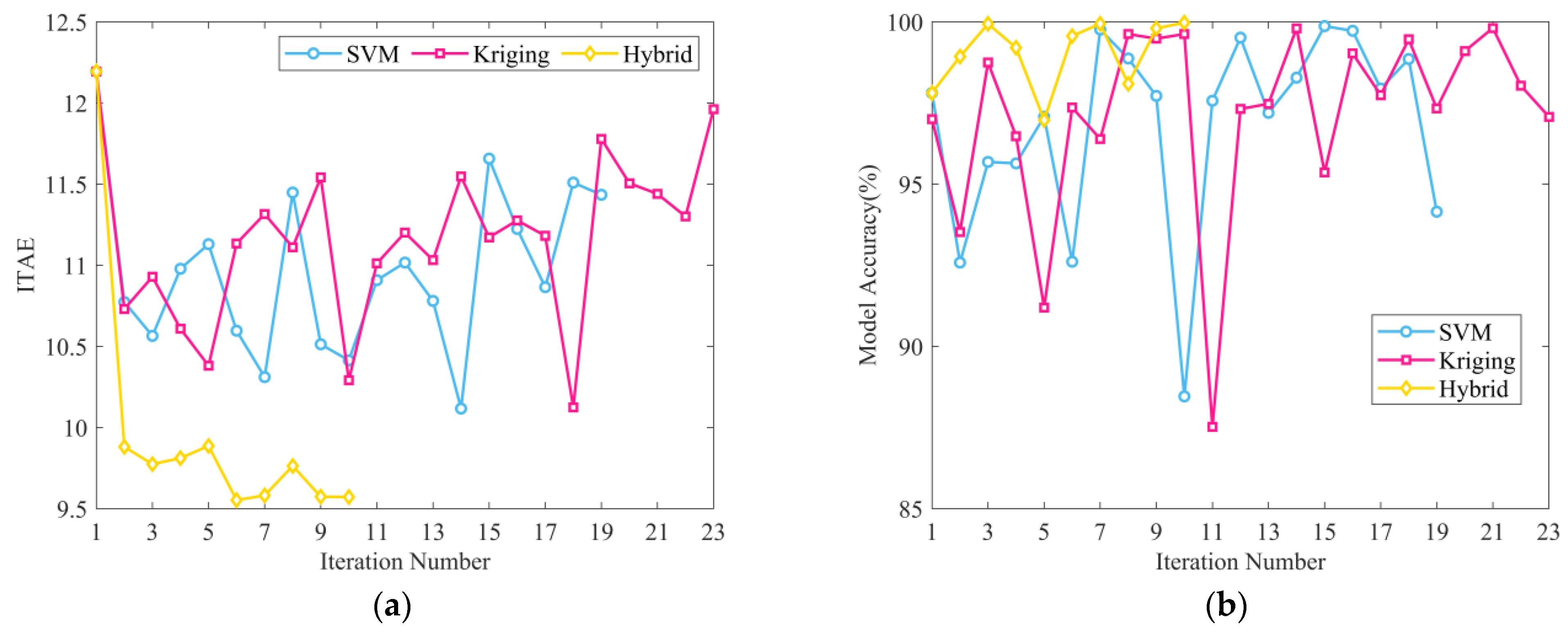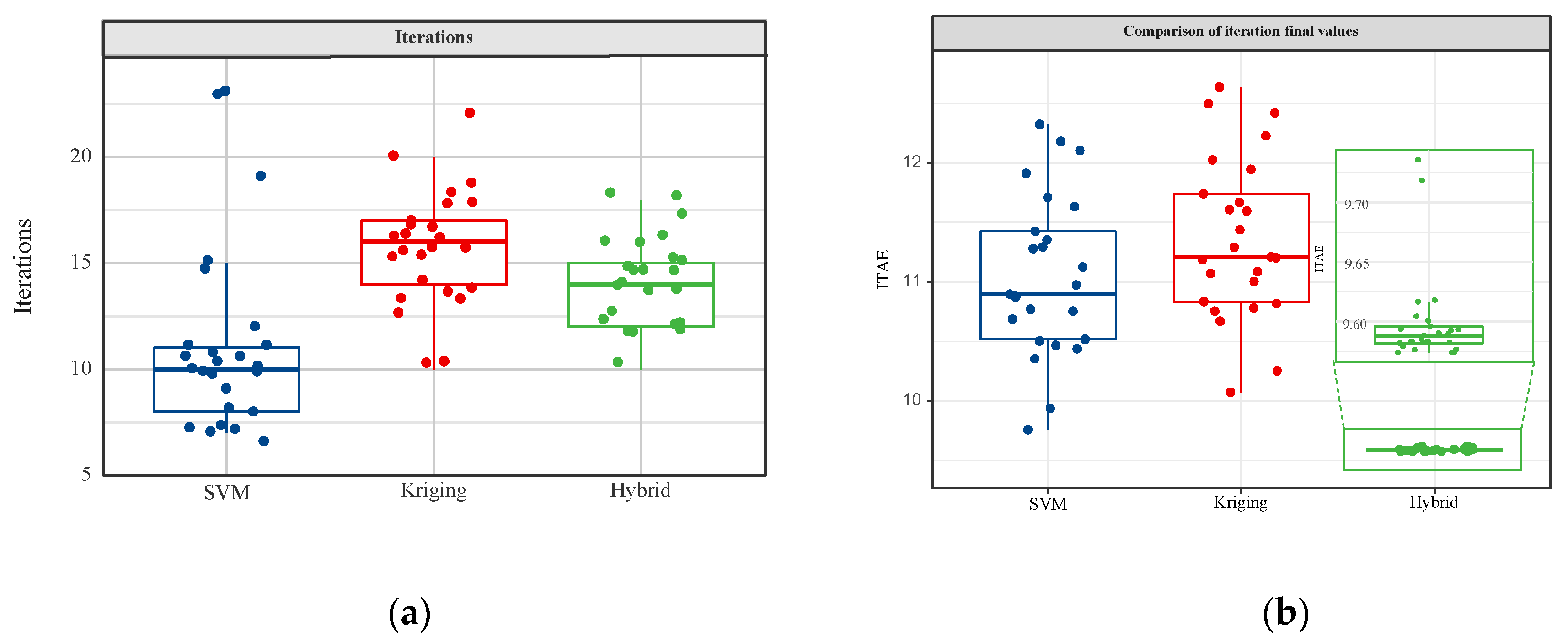1. Introduction
The steam generator (SG) is one of the crucial pieces of equipment in pressurized water reactor nuclear power plants [
1,
2]. During the operation of the SG, a significant deviation between the actual and set liquid levels may result in equipment failures that can adversely impact production efficiency [
3,
4]. The SG water level process exhibits highly nonlinear and time-varying characteristics, and traditional fixed-parameter level control methods lack optimization, adaptivity, self-learning, and other functions. To enhance the water level control performance of the steam generator, it is necessary to adjust the parameters of the level control system during the commissioning and operation processes of the nuclear power plant. The parameter tuning method based on engineer experience has drawbacks such as high cost and low efficiency. The swarm intelligence optimization method without relying on the model achieves the automation and intelligence of parameter optimization, while the optimization cost is high and the feasibility and practicability for engineering are poor [
5,
6,
7]. The model-based optimization method contains the advantages of swarm intelligence optimization methods that are not model-based. However, establishing an accurate control system model is difficult, which makes it difficult to ensure the optimality of the tuning parameters. None of the above parameter optimization methods can adequately solve the problem of parameter tuning in steam generator level control systems [
8,
9,
10,
11,
12,
13,
14]. To address the challenges encountered in the parameter tuning process of the steam generator liquid level control system, it is necessary to find an efficient optimization method for parameter tuning.
Based on the above analysis, to address the problem of model errors in model-based optimization methods, this paper constructs an initial small-sample dataset through experimental design and uses SVM and Kriging models constructed from the small-sample dataset as initial models. To overcome the issue of requiring a large number of experiments to ensure model accuracy, this study utilizes optimization iteration process data to guide the optimization process within a data-driven framework [
15,
16,
17,
18]. this optimization framework is achieved by continuously updating the modeling dataset with the process data generated during the iteration process and using the updated dataset to establish a more accurate model in a reconstructed manner.
2. Performance Optimization of the Steam Level Control System
The SG level control process is to change the current steam generator level height to meet the set requirements by changing the feed water flow [
15]. The framework for performance optimization of the steam generator liquid level control system is shown in
Figure 1. This optimization framework consists mainly of three parts: the steam generator water level control system, performance evaluation, and optimization algorithm.
In the optimization process of the SG level control system, the control parameters are first input into the SG level control system and the level response is obtained. Secondly, the corresponding level response of the current control parameters is analyzed for the control performance. The performance index formula is as follows:
where
represents the deviation between the actual water level and the set water level,
represents time, while
is the evaluation period.
Finally, if the performance index does not meet the evaluation criteria of optimization termination, the control parameters are set by the optimization algorithm to achieve the performance optimization of the SG level control system.
3. Optimization Method Based on Hybrid Iterative Model Reconstruction
3.1. Hybrid Model Idea
Currently, there are mainly two problems with model optimization methods: (1) high-precision models require a large number of sample datasets to be established and (2) single models exhibit low fitness during the optimization process.
To address the aforementioned problem, this paper proposes a hybrid modeling method based on the traditional single-model optimization concept. This method is inspired by how individuals perceive the world in real life. In the process of individual understanding of the world, it mainly relies on learning to build a complete world model. However, relying solely on the information in one book to establish a personal worldview can often lead to bias (the traditional single-model optimization idea). Therefore, when the information in one book does not meet the needs of personal worldview building, individuals should read books of other types and use the information in different books to establish a more accurate worldview (the hybrid-model optimization idea).
This paper proposes a data-driven hybrid iterative model reconstruction and optimization method based on the combination of data-driven and hybrid model ideas. The method is applied to the optimization of the liquid level control performance of a nuclear power plant steam generator, as shown in
Figure 2.
3.2. Hybrid Iterative Model Reconstruction Optimization Framework
Based on the characteristics of the optimization problem in Equation (1), this paper combines the data-driven optimization idea with the model optimization idea and designs a hybrid iterative model reconstruction optimization framework as shown in
Figure 3.
This framework combines data-driven ideas, utilizes system operation process data, and introduces running data into the model reconstruction process to achieve high-precision model establishment through a small number of samples. Meanwhile, the framework also combines the hybrid model idea to utilize different model building methods and adopts an accuracy-first strategy to select the most effective model in the current batch, thus maximizing the utilization of different models’ fitness in the optimization process.
3.3. The Process of Hybrid Iterative Model Reconstruction Optimization
The specific process of the hybrid iterative model reconstruction and optimization is shown in
Figure 4, and the specific steps are as follows:
Numerical initialization. Determine the parameters to be optimized in the control system and their corresponding feasible domains and set the termination criterion for the iteration.
Generate initial model samples. To ensure the randomness of the initial sample within the value range, this paper uses Latin hypercube sampling for the initial sample extraction. This method divides the value range of each dimension into several equal parts and randomly selects one point from each part to ensure an even distribution of values in each dimension.
Hybrid model construction. SVM and Kriging models are constructed separately based on the modeling data samples.
Model selection. Calculate the accuracy of the two types of models and select the high-precision model as the effective model for the current iteration batch through the model selection mechanism.
The formula for calculating the model’s accuracy is shown in Equation (2):
In Equation (2), represents the model accuracy, represents the model predicted value, and represents the response to the actual output value.
The model selection mechanism is as follows: if the accuracy of model 1 is higher at the current iteration point, then model 1 will be used in the next iteration; if the accuracy of model 2 is higher at the current iteration point, then model 2 will be used in the next iteration, as shown in Equation (3).
In Equation (3), represents the model used in the k + 1 iteration, represents model 1, represents model 2, represents the model accuracy of model 1 in the kth iteration, and represents the model accuracy of model 2 in the kth iteration.
- 5.
Calculating the optimal point of the model using PSO. The particle swarm optimization algorithm is used to calculate the optimal point of the effective model in the current iteration batch [
18].
- 6.
The liquid level response process. The SG liquid level control system experiment is performed with the optimal point of the effective model in the current iteration batch and the performance of the control system is analyzed. The performance evaluation index of the control system is shown in Equation (1).
- 7.
Termination criteria for iteration. Check whether the performance indicator meets the pre-set optimization termination criteria [
15]. If it meets the criteria, stop the current optimization process and iteration, output the current parameter values and performance; if not, update the modeling dataset using the experimental data of the SG liquid level control system and return to step 3 to continue a new round of iterative optimization.
4. Results and Discussions
4.1. Simulation Experiment Settings
For ease of comparison, all experiments will adopt the same iteration termination control strategy and the same initial point within the feasible domain of SG controller parameters.
4.2. Research on Small-Sample Fitting Models
To implement the optimization framework described above, the selection of model 1 and model 2 in
Figure 3 is performed first, in is paper, studies which model to choose as a small sample model. In this paper, the Kriging model and SVM model are used as model 1 and model 2, respectively, in the optimization framework [
18].
4.3. Effectiveness Test
Effectiveness is examined by comparing the two single-model optimization methods of the Kriging model and SVM model with the optimization method based on the Kriging and SVM hybrid iterative model reconstruction, as shown in
Figure 5a. In addition, observe the model accuracy data of the iterative model method, as shown in
Figure 5b.
From
Figure 5, it can be seen that the two single-model optimization methods of Kriging and SVM require 10 and 23 iterations, respectively, while the hybrid iterative model reconstruction optimization method based on both Kriging and SVM only requires 10 iterations, which can quickly approach the optimal solution. In addition, as the number of iterations increases, the model accuracy in the hybrid iterative model reconstruction method remains above 95%, while the model accuracy in the two single-model optimization methods varies greatly. This indicates that the hybrid iterative model reconstruction method has high optimization efficiency.
4.4. Efficiency Test
Through the above experiments, it has been demonstrated that the hybrid iterative model reconstruction optimization method is effective for performance optimization of the SG level system. However, in order to reduce the impact of algorithmic randomness on optimization results, 25 batches of experiments were conducted for the three optimization methods, and the number of iterations and the optimal value of iterations are shown in
Figure 6.
In the efficiency test, the average number of iterations for the hybrid iterative model optimization method was 13.86, which increased by 26.7% compared to SVM and decreased by 17.75% compared to Kriging. The average final iteration value for this method was 9.63, which decreased by 13.57% and 16.27%, respectively, compared to the other two methods.
Although the hybrid iterative model reconstruction optimization method based on the Kriging model and SVM model performs better in terms of optimization results, the optimization efficiency obtained through it has not improved. The performance of the hybrid iterative model reconstruction optimization method in terms of optimization efficiency is slightly worse than that of the single-model optimization method based on the SVM model. However, this difference is very small, so we can still conclude that the hybrid iterative model reconstruction optimization method based on the Kriging model and SVM model sacrifices a little optimization efficiency in exchange for the improvement of performance indicators. Therefore, the hybrid iterative model reconstruction optimization method based on the Kriging model and SVM model is still an effective method.
5. Results and Discussions
In this study, a hybrid iterative model reconstruction optimization method was proposed and applied to the performance optimization of the SG level control system in a steam generator. By introducing the fusion idea and implementation mechanism of process data and hybrid models driven together under the data-driven framework, the hybrid iterative model reconstruction optimization method can achieve the performance optimization of the control system. This method not only maximizes the advantages of different modeling mechanisms but also fully utilizes historical information generated during the optimization process in order to participate in the optimization process. Simulation experiments have shown that this method, compared with the single-model optimization method, has increased the iteration number by 26.7% and reduced it by 17.75%, respectively, and reduced the final iteration value by 13.57% and 16.27%, respectively.
Therefore, it can be concluded that the hybrid iterative model reconstruction optimization method is an efficient method for performance optimization of the SG level control system. This method can be applied to other similar controller parameter optimization problems in various nuclear power plant process control systems.
Author Contributions
Conceptualization, X.L., X.K. and C.S.; data curation, X.L., Z.Y. and J.S.; formal analysis, X.L. and X.K.; funding acquisition, X.L., X.K. and C.S.; investigation, X.L., X.K., Z.Y., J.S. and C.S.; project administration, X.L., X.K. and C.S.; visualization, X.L. and Z.Y.; writing—original draft, X.L., X.K. and Z.Y.; writing—review and editing, X.L., X.K. and Z.Y. All authors have read and agreed to the published version of the manuscript.
Funding
This research was funded by the program of the State Key Laboratory of Nuclear Power Safety Monitoring Technology and Equipment of China (K-A2020.412), the Natural Science Foundation of Fujian Province, grant numbers 2021J011205 and 2018J01564, and the postgraduate Innovation Program of Xiamen University of Technology, grant number YKJCX2022004.
Institutional Review Board Statement
Not applicable.
Informed Consent Statement
Not applicable.
Data Availability Statement
Not applicable.
Conflicts of Interest
The authors declare no conflict of interest.
Abbreviations
| SG | Steam Generator |
| SVM | Support Vector Machine |
| BP | Back Propagation |
| PID | Proportional–Integral–Derivative |
| ITAE | Time multiplied by Absolute Error |
References
- Wang, N.; Zhu, J.M.; Hu, Y.S.; Zhang, W.; Chen, T.M. Study on the False Water Level Phenomenon of the Steam Generator and SG Water Level Control. Nucl. Sci. Eng. 2022, 42, 1077–1084. [Google Scholar]
- Zhu, J.M.; Hu, Y.S.; Zhang, W.; Xiao, H. Study on the Uncertainty Analysis of Steam Generator Water Level. Nucl. Sci. Eng. 2020, 40, 353–358. [Google Scholar]
- Deng, T. The Desing and Optimization Research on Steam Generator Level Control System. Master’s Thesis, Shanghai Jiao Tong University, Shanghai, China, 2020. [Google Scholar]
- Zhang, B.T. Research on Steam Emission Characteristics of Secondary Side of Nuclear Power Unit. Master’s Thesis, North China Electric Power University, Beijing, China, 2021. [Google Scholar]
- Peng, W.; Zhang, D.F. Optimization of Steam Generator Water Level Control Based on Improved Particle Swarm Optimization. Ship Ocean Eng. 2010, 39, 208–210. [Google Scholar]
- Li, F.Y.; Zhang, D.F.; Wang, S.M.; Cui, C.L.; Liu, Y. PID Control for Nuclear Steam Generator Water Level Based on Genetic Algorithm. At. Energy Sci. Technol. 2008, 42, 137–141. [Google Scholar]
- Huang, W.; Yang, S.S. Optimal Control of Nuclear Power Plant Steam Generator Based on GMFAC. Nucl. Sci. Eng. 2017, 38, 81–86. [Google Scholar]
- Xiang, H.Y.; Chen, J.C.; Huang, Z.G.; Chen, K.L.; Liu, P. Adjustment for ACPR1000 Nuclear Plant SG level control. Nucl. Sci. Eng. 2019, 39, 758–764. [Google Scholar]
- Na, M.G. Design of a steam generator water level controller via the estimation of the flow errors. Ann. Nucl. Energy 1995, 22, 367–376. [Google Scholar]
- Wu, J.Y. Study on the Internal Flow and Structural Mechanics Characteristics of Main Feed Water Regulating Valve in the Second Loop of Nuclear Power Plant. Ph.D. Thesis, Zhejiang University, Zhejiang, China, 2022. [Google Scholar]
- Li, F.Y.; Lu, G.B.; Zhang, L.F.; Liu, D. Improved Double PI Control for Nuclear Steam Generator Water Level. At. Energy Sci. Technol. 2010, 44, 279–282. [Google Scholar]
- Cheng, Q.M.; Cheng, Y.M.; Xue, Y.; Hu, X.Q. The Applied Research on ADRC Based on Chaos-PSO Optimization in SG Water Level Control. East China Electr. Power 2011, 6, 957–963. [Google Scholar]
- Cheng, D.K.; Cheng, D.F. A simulation of identification and control for steam generator water level based on wavelet neural network. J. Nav. Univ. Eng. 2006, 6, 106–109. [Google Scholar]
- Cheng, Y.Q. PID Furnace Temperature Control based on Z-N Algorithm. J. Dalian Jiaotong Univ. 2008, 29, 50–53. [Google Scholar]
- Jiang, S.B. Data-Driven Based Performance Optimization Method for Steam Generator Liquid Level Control System. Master’s Thesis, Xiamen University of Technology, Xiamen, China, 2021. [Google Scholar]
- Kong, X.S.; Guo, J.M.; Zheng, D.B.; Zhang, J.; Fu, W. Quality control for medium voltage insulator via a knowledge-informed SPSA based on historical gradient approximations. Processes 2020, 8, 146. [Google Scholar] [CrossRef]
- Kong, X.S.; Guo, J.M.; Zheng, D.B.; Yang, J.F.; Zhang, J.; Fu, W. An improved-SPSA Quality Control Method for Medium Voltage Insulator SPSA. Gao Xiao Xue Gong Cheng Xue Bao/J. Chem. Eng. Chin. Univ. 2020, 34, 1500–1510. [Google Scholar]
- Xu, H.Q.; Li, L.k.; Shi, C.Q.; Li, X.Y.; Geng, P.C.; Kong, X.S. Parameter Optimization Method of Steam Generator Level Controller based on SVM and Improved PSO. In Proceedings of the 2022 10th China Automation Congress (CAC), Xiamen, China, 25 November 2022. [Google Scholar]
| Disclaimer/Publisher’s Note: The statements, opinions and data contained in all publications are solely those of the individual author(s) and contributor(s) and not of MDPI and/or the editor(s). MDPI and/or the editor(s) disclaim responsibility for any injury to people or property resulting from any ideas, methods, instructions or products referred to in the content. |
© 2023 by the authors. Licensee MDPI, Basel, Switzerland. This article is an open access article distributed under the terms and conditions of the Creative Commons Attribution (CC BY) license (https://creativecommons.org/licenses/by/4.0/).
